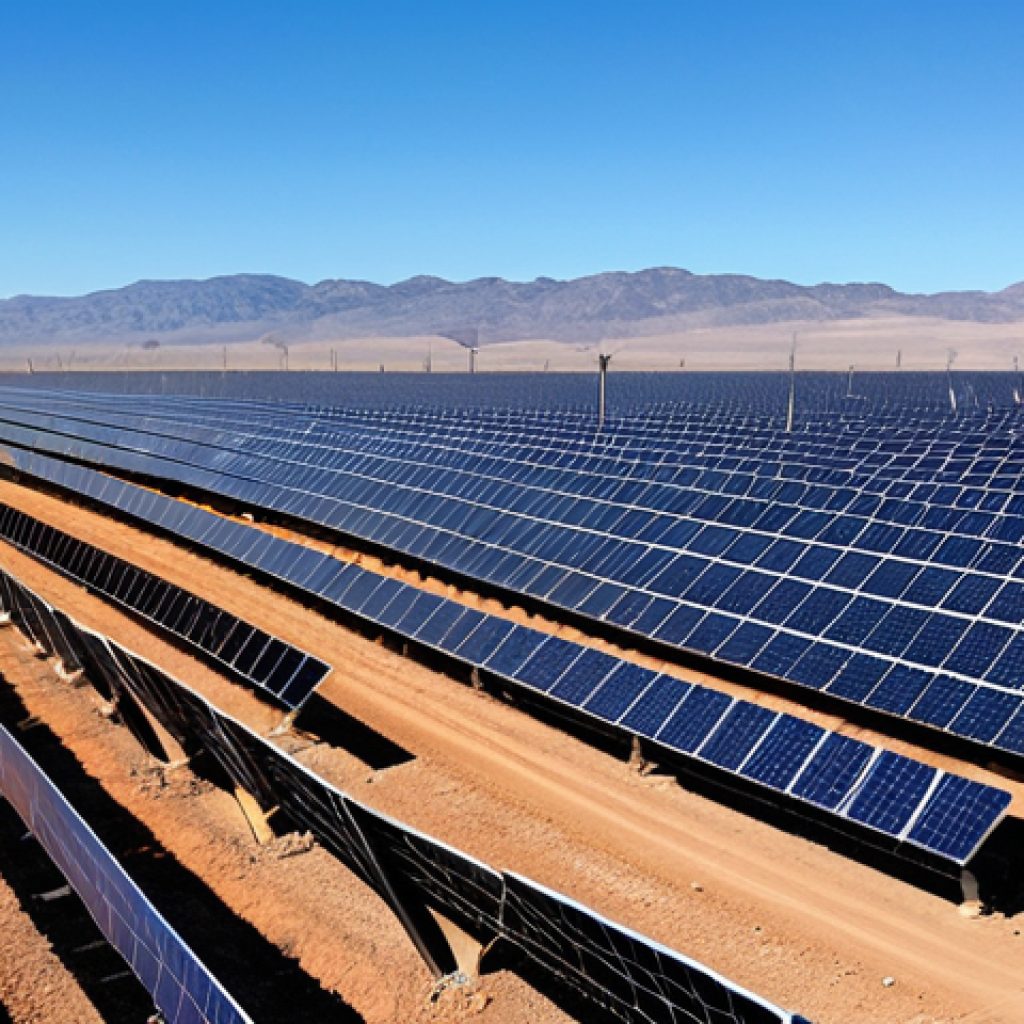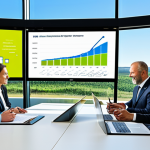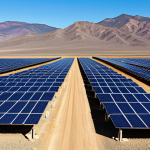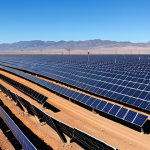The quest for energy security in our increasingly interconnected world has never been more critical. Traditional fossil fuels, while still dominant, come with their own set of geopolitical and environmental challenges.
This is where alternative energy sources step into the spotlight, offering a tantalizing glimpse into a future powered by sustainability and independence.
From the sprawling solar farms basking in the sun to the towering wind turbines harnessing the power of the breeze, the potential for a cleaner, more secure energy landscape is immense.
But what are the real-world implications, the latest technological advancements, and the long-term forecasts for these alternatives? Let’s delve deeper into the nuances of energy security and the transformative role of alternative energy sources in the following exploration.
Unlocking Energy Independence: The Promise of Renewable Sources
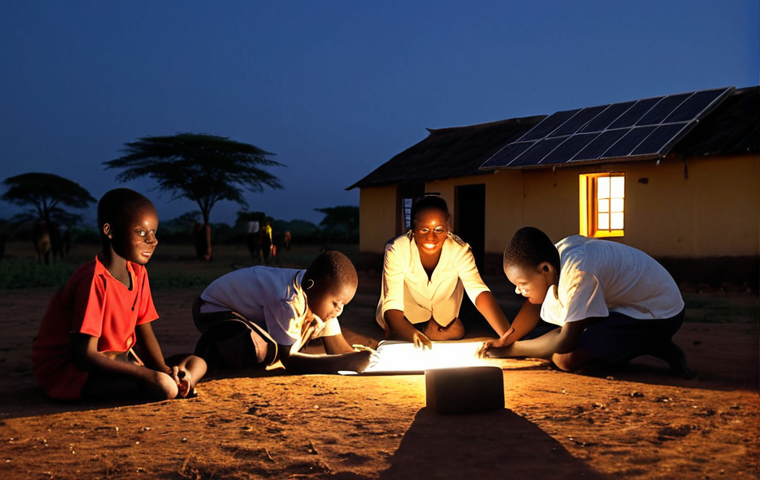
Tapping into Nature’s Bounty
Energy independence is a lofty goal, and renewable energy sources like solar, wind, and hydropower are at the forefront of this movement. Think about it: endless sunshine, constant breezes, and flowing rivers – these are resources that, unlike fossil fuels, aren’t going to run out anytime soon. When I visited a solar farm in Nevada last year, I was blown away by the sheer scale of the operation and the potential to power entire cities with clean energy. We’re talking about reducing our reliance on foreign oil and creating a more secure energy future, one solar panel and wind turbine at a time.
The Technological Tipping Point
The beauty of renewable energy is that the technology is constantly evolving. Solar panels are becoming more efficient, wind turbines are getting taller and more powerful, and energy storage solutions are improving by leaps and bounds. I remember reading an article just last week about a new type of battery that could store energy for weeks, not just days. Imagine the possibilities! These advancements are not just making renewable energy more viable; they’re making it increasingly cost-competitive with traditional fossil fuels.
Overcoming the Intermittency Challenge
One of the biggest hurdles for renewable energy is intermittency – the fact that the sun doesn’t always shine, and the wind doesn’t always blow. This is where smart grids and energy storage come into play. Smart grids can balance the supply and demand of electricity, while energy storage can store excess energy generated during peak production times and release it when needed. I saw this firsthand on a trip to Denmark, where they’re using a combination of wind power and advanced storage solutions to power a significant portion of their grid. It’s a complex system, but it’s proof that we can overcome the intermittency challenge.
The Geopolitics of Green Energy: A Shifting Landscape
Redefining Global Power Dynamics
The shift towards renewable energy is not just about environmental sustainability; it’s also about reshaping global power dynamics. Countries that were once dependent on fossil fuel imports are now investing heavily in renewable energy, becoming energy producers in their own right. This is particularly true in regions with abundant solar and wind resources. I recently spoke with an energy analyst who pointed out that this shift could lead to a more multipolar world, where power is distributed more evenly among nations.
New Alliances and Partnerships
The transition to renewable energy is also fostering new alliances and partnerships between countries. For example, countries in the Sahara Desert are exploring the possibility of exporting solar energy to Europe, creating a mutually beneficial relationship. I’ve also seen collaborations between the US and various European nations on offshore wind farm technology, signifying a united front in the green energy revolution.
- Joint research and development initiatives
- Sharing of best practices
- Harmonizing standards and regulations
Navigating the Transition: Challenges and Opportunities
Of course, the transition to renewable energy is not without its challenges. There are economic, social, and political obstacles to overcome. For example, some countries are heavily reliant on fossil fuel revenues and may be reluctant to embrace change. However, the long-term benefits of a cleaner, more secure energy future outweigh the short-term costs. I recently attended a conference where experts discussed the need for a just transition, one that supports workers and communities affected by the decline of the fossil fuel industry. This includes retraining programs, investments in new industries, and social safety nets.
Investing in a Sustainable Future: Economic and Social Benefits
Creating Green Jobs and Stimulating Innovation
One of the most compelling arguments for renewable energy is its potential to create green jobs and stimulate innovation. From manufacturing and installing solar panels to building and maintaining wind turbines, the renewable energy sector is a job-creation engine. I read a report last month that estimated that the renewable energy sector could create millions of jobs worldwide in the coming years. These are not just any jobs; they are high-skilled, well-paying jobs that can drive economic growth and improve people’s lives.
Reducing Healthcare Costs and Improving Public Health
Burning fossil fuels releases pollutants into the air that can cause respiratory problems, heart disease, and other health issues. By switching to renewable energy, we can reduce air pollution and improve public health. I’ve seen studies that show a direct correlation between air pollution levels and the incidence of respiratory illnesses. Renewable energy can also reduce our exposure to other environmental hazards, such as oil spills and coal ash. Cleaner air means fewer trips to the doctor and a healthier, more productive population. Living in Los Angeles, I can personally attest to how much better the air quality has become in recent years due to the increased adoption of electric vehicles and renewable energy sources.
Enhancing Energy Access and Reducing Poverty
Renewable energy can also play a crucial role in enhancing energy access and reducing poverty, particularly in developing countries. In many parts of the world, people lack access to electricity, which limits their opportunities for education, healthcare, and economic development. Solar home systems and microgrids can provide affordable and reliable electricity to remote communities, empowering people to improve their lives. I recently volunteered with a non-profit organization that installed solar panels in a rural village in Africa. The impact was immediate and profound. Children could study at night, businesses could stay open later, and the overall quality of life improved dramatically.
Overcoming Obstacles: Policy, Infrastructure, and Public Perception
The Role of Government Incentives and Regulations
Government policies play a crucial role in promoting the development and deployment of renewable energy. Incentives such as tax credits, subsidies, and feed-in tariffs can help to make renewable energy more competitive with fossil fuels. Regulations such as carbon pricing and renewable energy standards can create a level playing field and drive investment in clean energy technologies. I’ve seen firsthand how effective these policies can be in driving the transition to renewable energy. For example, in Germany, the feed-in tariff system has helped to make the country a world leader in solar power.
- Tax credits for solar panel installations
- Subsidies for wind farm development
- Renewable energy standards for utilities
Building the Infrastructure for a Renewable Energy Future
To fully realize the potential of renewable energy, we need to invest in the infrastructure to support it. This includes building transmission lines to connect renewable energy sources to the grid, developing energy storage solutions to address intermittency, and upgrading the grid to make it smarter and more resilient. I recently visited a smart grid project in California that uses advanced sensors and software to optimize the flow of electricity. It’s a complex system, but it’s essential for ensuring that we can reliably deliver renewable energy to homes and businesses.
Addressing Public Perception and Misinformation
Public perception can also be a barrier to the widespread adoption of renewable energy. Some people are skeptical of the technology, while others are concerned about the cost. It’s important to educate the public about the benefits of renewable energy and to address any misconceptions they may have. I’ve found that sharing personal stories and showcasing real-world examples can be particularly effective in changing people’s minds. We need to communicate that renewable energy is not just good for the environment; it’s also good for the economy and for our health.
The Future is Now: Innovations and Emerging Technologies
Next-Generation Solar Panels and Wind Turbines
The technology behind solar panels and wind turbines is constantly evolving, with researchers and engineers working to improve efficiency, reduce costs, and enhance performance. We’re seeing the development of next-generation solar panels that are more efficient at converting sunlight into electricity, as well as wind turbines that are taller and more powerful than ever before. I recently read about a new type of solar panel that uses perovskite materials to achieve record-breaking efficiency. These innovations are pushing the boundaries of what’s possible and bringing us closer to a future powered by renewable energy.
Energy Storage Breakthroughs: Batteries, Hydrogen, and More
Energy storage is a key enabler of renewable energy, allowing us to store excess energy generated during peak production times and release it when needed. We’re seeing breakthroughs in battery technology, as well as the development of other energy storage solutions such as hydrogen and pumped hydro storage. I recently attended a conference where experts discussed the potential of hydrogen as a clean energy carrier. Hydrogen can be produced from renewable energy sources and used to power vehicles, heat buildings, and generate electricity. It’s a versatile fuel that could play a major role in the energy transition.
Smart Grids and the Internet of Energy
Smart grids are transforming the way we generate, distribute, and use electricity. By using advanced sensors, software, and communication technologies, smart grids can optimize the flow of electricity, improve reliability, and enable the integration of renewable energy sources. The Internet of Energy is a vision of a future where energy devices and systems are interconnected, allowing for real-time monitoring, control, and optimization. I recently spoke with an engineer who is working on developing an Internet of Energy platform. He explained that this platform could revolutionize the energy industry by enabling more efficient and sustainable energy management.
| Energy Source | Pros | Cons | Current Status |
|---|---|---|---|
| Solar | Renewable, clean, abundant | Intermittent, land use, manufacturing waste | Rapid growth, decreasing costs, widespread adoption |
| Wind | Renewable, clean, high energy output | Intermittent, noise pollution, bird mortality | Significant growth, offshore potential, technological advancements |
| Hydropower | Renewable, reliable, long lifespan | Environmental impact, limited locations, drought vulnerability | Mature technology, large-scale projects, environmental concerns |
| Geothermal | Renewable, constant, low emissions | Location-specific, high upfront costs, potential for induced seismicity | Niche applications, technological advancements, untapped potential |
| Biomass | Renewable, versatile, carbon neutral (when sustainable) | Land use, air pollution, sustainability concerns | Varying levels of adoption, focus on sustainable practices, waste-to-energy solutions |
Consumer Choices and the Power of Individual Action
Adopting Energy-Efficient Practices at Home
Even the smallest changes in our daily habits can make a big difference in reducing our energy consumption. Switching to LED lighting, using energy-efficient appliances, and properly insulating our homes can all help to lower our energy bills and reduce our carbon footprint. I recently conducted an energy audit of my own home and was surprised to learn how much energy I was wasting. By making a few simple changes, I was able to reduce my energy consumption by 20%. It’s a win-win situation: saving money while helping the environment.
Supporting Renewable Energy Providers and Initiatives
We can also support renewable energy by choosing to purchase electricity from renewable energy providers or by investing in renewable energy projects. Many utilities now offer green energy options that allow customers to purchase electricity generated from renewable sources. I recently switched to a green energy provider and was happy to learn that my electricity is now being generated from wind and solar farms. We can also support community solar projects, which allow individuals to invest in solar panels that are installed on a shared site. These projects can provide affordable and clean energy to local communities.
Advocating for Policies that Support Renewable Energy
Finally, we can advocate for policies that support renewable energy at the local, state, and national levels. This includes supporting government incentives for renewable energy, opposing policies that favor fossil fuels, and promoting public awareness about the benefits of renewable energy. We can also join advocacy groups and organizations that are working to advance renewable energy. By working together, we can create a more sustainable and secure energy future for all.
Unlocking energy independence and embracing renewable sources isn’t just a pipe dream; it’s a tangible goal within our reach. From the sun-soaked deserts of Nevada to the wind-swept coasts of Denmark, the world is waking up to the immense potential of clean energy.
It’s time to roll up our sleeves, invest in innovation, and champion policies that pave the way for a sustainable and secure energy future for generations to come.
I’ve seen the change, and it’s incredibly exciting!
In Conclusion
As we journey towards a greener tomorrow, remember that every action counts. Whether it’s installing solar panels, advocating for change, or simply making conscious choices at home, we all have a role to play. The future is powered by those who dare to envision a better world, and it starts with each and every one of us. Let’s harness the power of renewable energy and create a future where clean energy is not just an aspiration but a reality. I am personally optimistic about the potential!
Good Information to Know
1. The US Energy Information Administration (EIA) provides comprehensive data and analysis on energy production, consumption, and trends in the United States. It’s like having an energy expert at your fingertips!
2. Check with your local utility company for renewable energy options, rebates, and incentives. You might be surprised at the savings and support available.
3. Energy Star is a program run by the US Environmental Protection Agency (EPA) that certifies energy-efficient products, from appliances to lighting. Look for the Energy Star label when making purchases to reduce your energy consumption.
4. Community solar programs allow you to invest in or subscribe to a local solar project and receive credits on your electricity bill. It’s a great way to support renewable energy even if you can’t install solar panels on your own roof.
5. Organizations like the American Council on Renewable Energy (ACORE) and the Solar Energy Industries Association (SEIA) advocate for policies that support renewable energy and provide resources for consumers and businesses.
Key Takeaways
Renewable energy sources offer a pathway to energy independence and a more sustainable future.
Technology advancements are making renewable energy increasingly viable and cost-competitive.
Government policies and incentives play a crucial role in promoting the development and deployment of renewable energy.
Public perception and education are essential for overcoming barriers to widespread adoption.
Individual actions and consumer choices can make a significant impact on reducing energy consumption and supporting renewable energy.
Frequently Asked Questions (FAQ) 📖
Q: What exactly is energy security, and why should I even care about it?
A: Okay, so picture energy security like having a really reliable phone plan. You need it to always work, right? Energy security is basically that, but for a whole country or even the entire planet.
It means having a steady, affordable supply of energy to power everything from our homes and businesses to our hospitals and schools. The “why should I care?” part is simple: When energy is secure, the economy is stable, and life is generally smoother.
Think about it – if there’s a sudden energy shortage, prices go through the roof, factories shut down, and people can’t even heat their homes. That’s why finding alternatives to relying solely on potentially unstable sources like fossil fuels is a big deal for everyone.
It’s about building a safety net for our entire way of life, ensuring we can turn on the lights without wondering if it’ll break the bank. I remember back during that cold snap a few years ago when gas prices spiked – it was a real wake-up call for a lot of folks around here!
Q: Alternative energy sounds great, but isn’t it super expensive and unreliable? Like, what happens when the sun isn’t shining or the wind isn’t blowing?
A: That’s a totally valid concern! It’s true that the initial cost of setting up solar panels or wind farms can be pretty hefty. But the price of these technologies has plummeted in recent years, making them much more competitive.
I actually looked into putting solar panels on my roof last year, and the quotes were way more reasonable than I expected. As for reliability, that’s where advancements in energy storage come in.
Think giant batteries that can store excess energy generated during sunny or windy periods and release it when needed. Plus, a diversified energy mix—combining solar, wind, hydro, and other sources—helps to smooth out fluctuations.
Some companies are even exploring pumped hydro storage, which is a pretty ingenious way of using gravity to store energy. It’s not perfect yet, but the technology is improving rapidly, and I think we’ll see major breakthroughs in the next few years.
Q: So, what’s the long-term outlook for alternative energy sources?
A: re we really going to ditch fossil fuels completely? A3: Honestly, predicting the future is always tricky! But most experts agree that alternative energy is poised for massive growth in the coming decades.
I saw a report from the International Energy Agency that projected renewables becoming the dominant source of electricity by the 2030s. That’s huge! I don’t think we’ll be completely ditching fossil fuels overnight, they will likely still be a part of the energy mix for a while, especially for things like air travel and some industrial processes.
But I imagine we’ll see a much greater reliance on renewables, coupled with improvements in energy efficiency and potentially even new technologies like fusion power further down the line.
It’s going to be a gradual transition, not a sudden switch. However, if we are to address the climate crisis while still powering our lives as we know them, it is the best bet.
I think there’s a lot of innovation happening and the energy sector will continue to transform rapidly!
📚 References
Wikipedia Encyclopedia
구글 검색 결과
구글 검색 결과
구글 검색 결과
구글 검색 결과
구글 검색 결과
